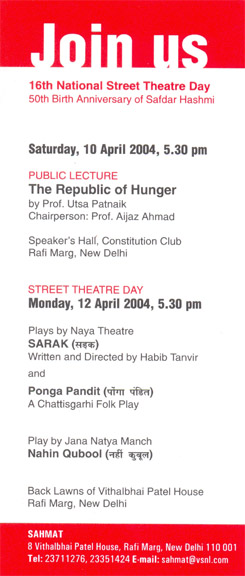Republic of Hunger Utsa Patnaik and
Street Theatre by Habib Tanveer JANAM
SAFDAR HASHMI’S
50TH BIRTH ANNIVERSARY
APRIL 12, 2004, the 50th birth anniversary of people’s artist, theatre activist and a member of the Communist Party of India (Marxist), Safdar Hashmi, was celebrated through out the country as National Street Theatre Day by SAHMAT and progressive theatre groups, artists, activists, intellectuals and others. The celebrations were held in a most befitting manner – the staging of plays which conveyed important political and social messages to the oppressed sections of our population.
In New Delhi, the back lawns of the Vithalbhai Patel House was the venue for remembering and paying tribute to Safdar Hashmi. Three plays were staged on this evening, each with a distinct message. Two of them were by Naya Theatre, the group led by the legendary Habib Tanvir. The first play was Sarak, written by Tanvir himself and it dealt with the hollowness of the rhetoric of development. It also brought out how one man’s developmental priorities may be different from that of the other. The issue of corruption and official apathy was also effectively dealt with in this play.
The second play staged was Ponga Pandit, which continues to attract vicious attacks from the sangh parivar while being staged in Madhya Pradesh and other places. As recently as two months ago this play was disrupted by VHP goons in Madhya Pradesh. “The play is the tale of a sweeper woman, who after being humiliated by the Pandit decides that she does not need anyone’s mediation to reach the God, and decides to take up her matters with him directly,” said director Habib Tanvir.
The third and last play of the day was Nahi Qubool by Jan Natya Manch group.
The gathering on this occasion expressed their strong condemnation of the series of attacks on cultural activists by the communal fascists in the recent past, including the latest one on the Youth Aman Karwan, a group of young persons travelling through the country for communal harmony in Baroda on April 11. SAHMAT in a statement condemned the totally unwarranted attack by the VHP, Bajrang Dal activists who are patronised by the ruling BJP and the RSS.
REPUBLIC OF HUNGER
This was preceded by a public lecture on April 10 by eminent economist, Professor Utsa Patnaik on the topic “The Republic of Hunger”. The well attended lecture was chaired by Professor Aijaz Ahmed. Professor Patnaik castigated the establishment economists for creating an illusion of ‘India Shining’ when the reality for the poor was exactly opposite.
Professor Utsa Patnaik said that on the basic issue of food availability, the “achievement” of five years of NDA rule has been to take India back to where she was at the time of independence; and the position at independence itself had been arrived at after a half-century of retrogression. Annual per capita foodgrain availability at the beginning of the twentieth century was around 200 kilograms; by independence it had declined to around 150 kilograms (the average for the Second World War years, which included the terrible Bengal famine being 148.5 kilograms). Strenuous efforts after independence raised it to around 180 kilograms by the end of the 1980s. The “Reforms Decade”, of the nineties, has seen first a stagnation and then a decline which has accentuated sharply during the NDA rule, the average figure for the three years ending in 2002-3 plummeting to 155 kilograms, compared to a 174 kilograms average during the three years ending in 1998. This being the average for the country, the figure for the poor, especially the rural poor, is obviously much lower, she said.
Professor Patnaik asserted that the pre-independence food crisis however was caused by a decline in per capita foodgrains production. In the nineties too there has been such a decline in per capita production, but superimposed upon this, there has been an even sharper fall in the purchasing power in the hands of the people, especially in rural India. This has resulted in the piling up of unsold foodstocks, even in the midst of growing hunger and declining calorie intake, despite a decline in per capita foodgrains production. The NSS consumption data for 1999-2000 showed that 70 percent of the rural population was below the daily calorie norm used for estimating poverty, and by now the situation would be worse since per capita foodgrains availability is even lower than at that date.
Citing figures from government sources, she said that one very important reason for the dwindling purchasing power in the hands of the people is the sharp cut in government development expenditure in rural areas. The NDA government, while handing out tax cuts for the rich, has drastically squeezed rural development expenditure, and precipitated this deflation of demand. Ironically, in order to get rid of the burgeoning foodstocks, it has even gone to the absurd length of exporting foodgrains to the unprecedented extent of 17 million tonnes in a severe drought year, at prices which are below what the Below-Poverty-Line population has to pay within the country. This incredible spectacle, of food squeezed out of a population going hungrier by the day being sold at highly subsidized prices in the world market, is then cited as an example of “India shining”!, she concluded.
 PHOTOS
PHOTOS  FRONT
FRONT  BACK
BACKCARD CARD